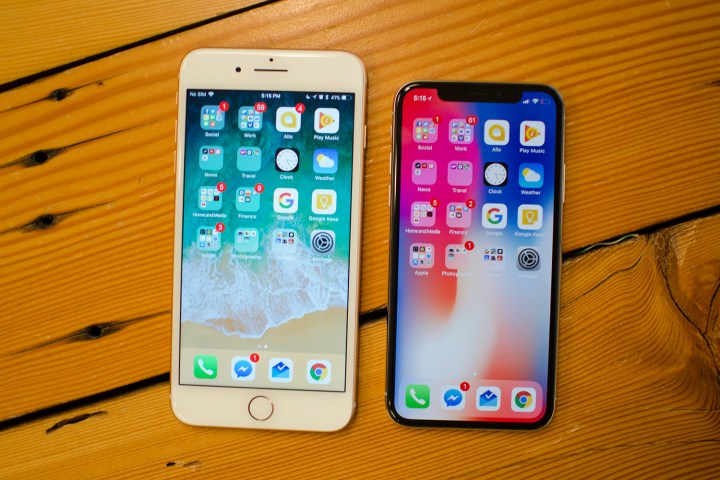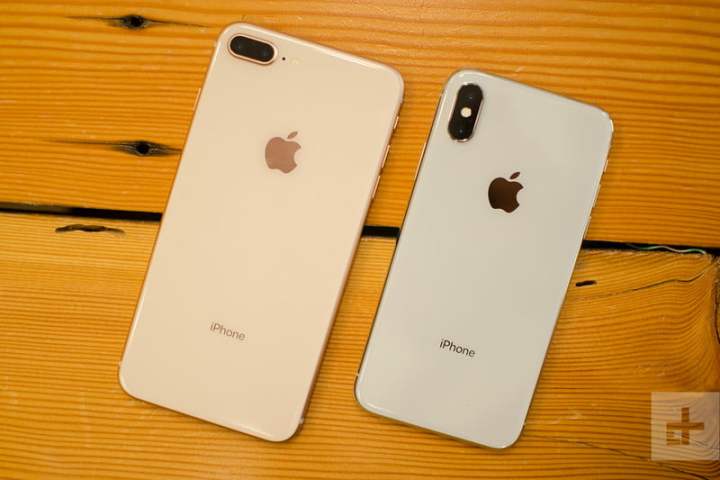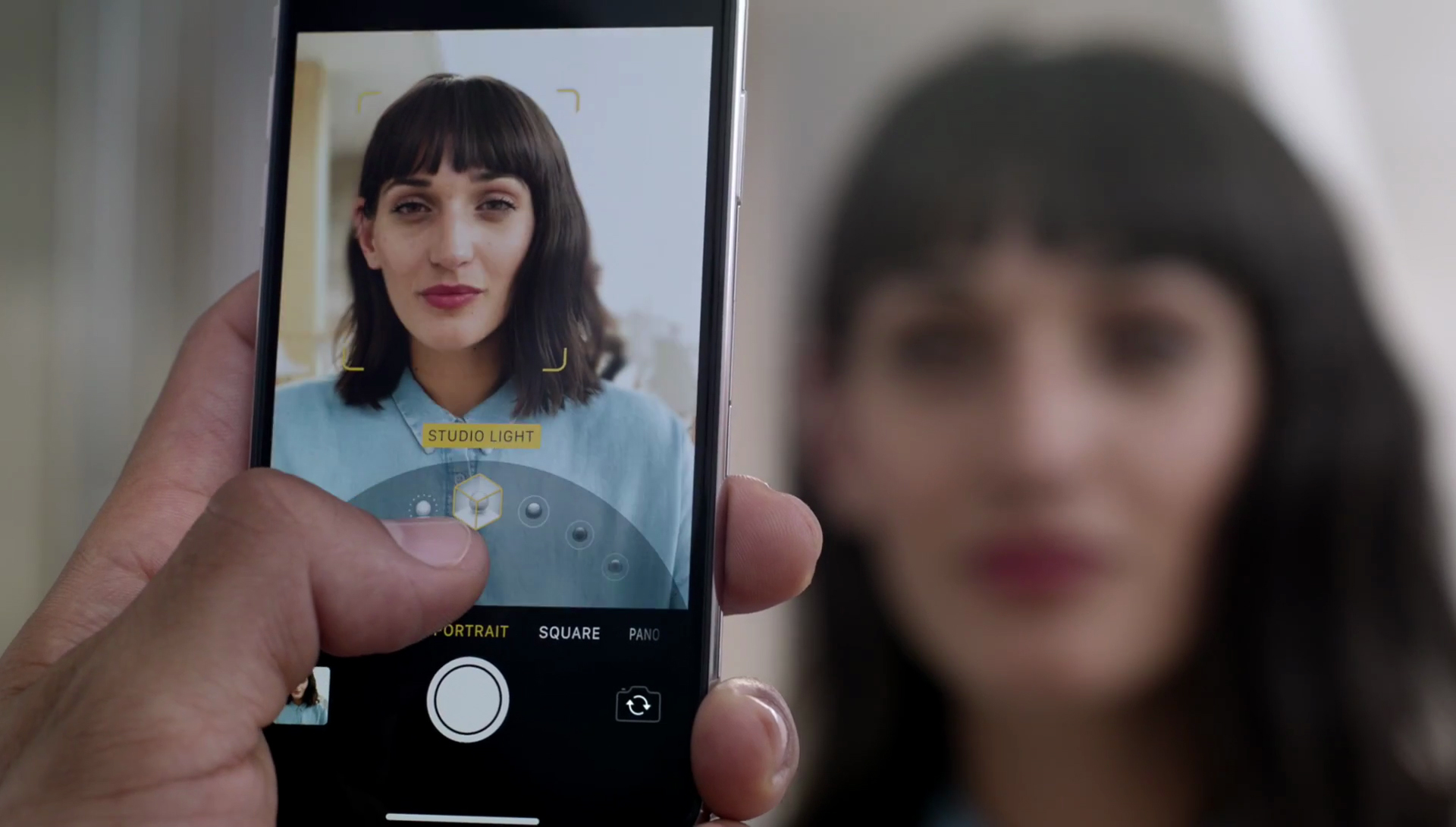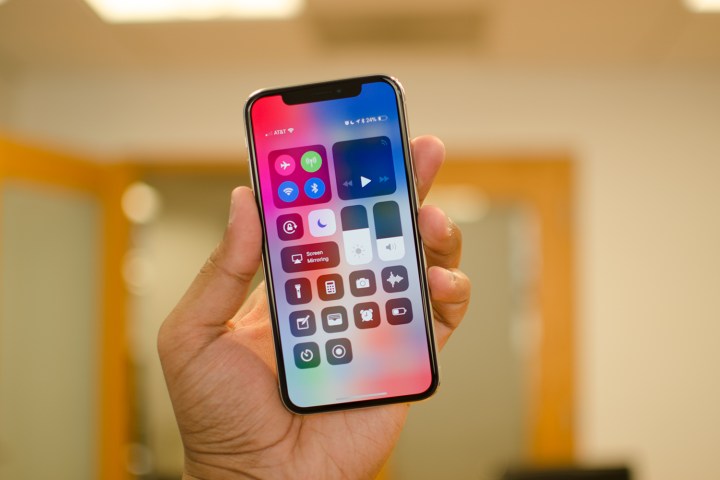The iPhone X was more than just another iPhone. It marked a top-to-bottom redesign with a bright and colorful edge-to-edge OLED screen, depth-sensing front-facing cameras, wireless charging, and the most powerful Apple-designed processor ever engineered to date. In other words, it was the Cadillac of smartphones, and that was reflected in its $1,000 price tag.
While the iPhone X and its successor, the iPhone XS, have now been discontinued by Apple, replaced by the iPhone 11 Pro, you can still find one if you look. The price of an iPhone X has dropped significantly, but the iPhone 8 and iPhone 8 Plus are cheaper still, and they also offer a redesigned all-glass back, improved cameras, the same speedy processor, and longer-lasting batteries. Apple is also still selling the iPhone 8 and 8 Plus.
How does the iPhone X compare to the iPhone 8 and 8 Plus? Check out our iPhone X vs. iPhone 8 vs. iPhone 8 Plus specs comparison for all the crucial differences you need to know about.
Specs
| iPhone 8 | iPhone 8 Plus | iPhone X | |
| Size | 5.45 x 2.65 x 0.29 inches | 6.24 x 3.07 x 0.30 inches | 5.65 x 2.79 x 0.30 inches |
| Weight | 148 grams (5.22 ounces) | 202 grams (7.13 ounces) | 174 grams (6.14 ounces) |
| Screen | 4.7-inch Retina HD LCD-backlit widescreen | 5.5-inch Retina HD LCD-backlit widescreen | 5.8-inch OLED Super Retina HD display |
| Resolution | 1334 x 750 pixels (326 pixels per inch) | 1920 x 1080 pixels (401 PPI) | 2436 x 1125 pixels (458 PPI) |
| OS | iOS 12 | iOS 12 | iOS 12 |
| Storage | 64, 256GB | 64, 256GB | 64, 256GB |
| MicroSD card slot | No | No | No |
| NFC support | Yes, Apple Pay only | Yes, Apple Pay only | Yes, Apple Pay only |
| Processor | A11 Bionic with 64-bit architecture, M10 motion coprocessor | A11 Bionic with 64-bit architecture, M10 motion coprocessor | A11 Bionic with 64-bit architecture, M10 motion coprocessor |
| RAM | 2GB | 3GB | 3GB |
| Connectivity | 4G LTE, GSM, CDMA, HSPA+, 802.11a/b/g/n/ac Wi-Fi | 4G LTE, GSM, CDMA, HSPA+, 802.11a/b/g/n/ac Wi-Fi | 4G LTE, GSM, CDMA, HSPA+, 802.11a/b/g/n/ac Wi-Fi |
| Camera | 12-megapixel camera, 7MP front | Dual 12-megapixel rear, 7MP front | Dual 12-megapixel rear, 7MP front |
| Video | Up to 4K at 60fps, 1080p at 240fps | Up to 4K at 60fps, 1080p at 240fps | Up to 4K at 60fps, 1080p at 240fps |
| Bluetooth | Yes, version 5 | Yes, version 5 | Yes, version 5 |
| Fingerprint sensor | Touch ID | Touch ID | None, Face ID |
| Other sensors | Barometer, 3-axis gyro, accelerometer, proximity sensor, ambient light sensor | Barometer, 3-axis gyro, accelerometer, proximity sensor, ambient light sensor | Depth sensors, barometer, 3-axis gyro, accelerometer, proximity sensor, ambient light sensor |
| Water-resistant | Yes, IP67 rated | Yes, IP67 rated | IP67 rated |
| Battery | 1,821 mAh
14 hours of talk time, 12 hours of internet use, 13 hours of video playback, and up to 40 hours of audio playback Fast charging offers up to 50 percent charge in 30 minutes. Wireless charging (Qi standard) |
2,675 mAh
21 hours of talk time, 13 hours of internet, 14 hours of video playback, and up to 60 hours of audio playback Fast charging offers up to 50 percent charge in 30 minutes Wireless charging (Qi standard) |
2,716 mAh
21 hours of talk time, 12 hours of internet, 13 hours of video playback, and up to 60 hours of audio playback Fast charging offers up to 50 percent charge in 30 minutes Wireless charging (Qi standard) |
| Ports | Lightning | Lightning | Lightning |
| Marketplace | App Store | App Store | App Store |
| Color offerings | Gold, silver, and space gray | Gold, silver, and space gray | Silver and space grey |
| Carriers | Verizon, AT&T, T-Mobile, Sprint | Verizon, AT&T, T-Mobile, Sprint | Verizon, AT&T, T-Mobile, Sprint |
| Price | $450 | $550 | $850 |
| DT review | 3.5 out of 5 stars | 4 out of 5 stars | 4.5 out of 5 stars |
Performance, battery life, and charging

When it comes to raw performance, the iPhone X and both iPhone 8 devices are more evenly matched than you might expect.
All three pack Apple’s 64-bit, A11 Bionic chip, a powerful processor consisting of six individual cores — two high-power cores and four power-efficient cores — that balance battery life with performance. The processor works in tandem with an Apple-designed three-core GPU that accelerates the iPhone’s machine learning algorithms. Overall, Apple says the A11 Bionic is up to to 70 percent faster than the A10 Fusion (the iPhone 7 and 7 Plus’ system-on-a-chip) in everyday tasks, and up 30 percent faster in graphics-heavy games and apps. We can confirm all three are lightning-fast in everyday use.
In terms of internal storage, you’ll find 64GB and 256GB flavors, which is ample room for apps, games, music, movies, and any other media you might want to store offline. But the playing field isn’t entirely even. The iPhone X and the iPhone 8 Plus have 3GB of RAM compared to the iPhone 8’s 2GB. That won’t be especially noticeable day to day, but depending on how aggressively you juggle apps and browser tabs, it might impact on your multitasking.
The iPhone 8 has by far the smallest battery at 1,821mAh, but we’re pleased to report that it actually lasts slightly longer than its predecessor, the iPhone 7, thanks to that more efficient processor. If stamina is important to you, then the iPhone 8 Plus has a slight edge over the iPhone X, and both will generally outlast their smaller sibling. All three iPhones support Qi wireless charging and all three support fast charging with the right kit, which is sadly not supplied in the box.
Winner: iPhone 8 Plus
Design and durability

The most obvious differences between the iPhone 8, iPhone 8 Plus, and the iPhone X are aesthetic. From the front, the iPhone 8 and 8 Plus look almost nothing like the iPhone X. The edge-to-edge design with that distinctive notch marks a clear break from the thicker, traditional bezels and home button of the iPhone 8 and 8 Plus. Even though the iPhone 8 Plus has a smaller 5.5-inch screen, it’s actually a bigger phone overall compared to the iPhone X, which has a 5.8-inch screen.
Both iPhone 8 devices retain the circular, fingerprint-scanning, Touch ID, home button that has become one of the iPhone’s most recognizable features. That is in stark contrast with the iPhone X, which replaces the home button with an on-screen “software bar” across the bottom of the screen. Swipe up from the bottom to get to the home screen, and it disappears when it’s not in use. It doesn’t support Touch ID, meaning the iPhone X can’t be unlocked with a fingerprint.
It can be unlocked with a face, however. The iPhone X packs a special depth-sensing sensor module consisting of a light transmitter, a light receiver, a proximity sensor, and an ambient light sensor that records depth data. This combined with data from the front camera builds a complete 3D image. It’s called True Depth, and it’s the technological underpinning of the iPhone X’s FaceID, iOS 11’s Animoji, and a new feature that prevents the phone from locking when you’re looking at it.
Apple says a custom neural network crunched through more than 1 billion images to develop True Depth’s image recognition software, and the machine learning-powered system can perform up to 600 billion operations per second. It’ll capture the unique contours and shape of your face over time, so it will still recognize you if you change your hairstyle or grow a beard. Further, Apple claims that it’s much more secure than Touch ID — the company stated the chances a random person could use their fingerprint to unlock your iPhone is 1 in 50,000, but that the odds of the same thing happening with Face ID are 1 in 1,000,000.
The iPhone X, iPhone 8 and 8 Plus feature a combination of aluminum and glass that’s durable, IP67 water-resistant, and shock-proof, and both eschew a 3.5mm audio jack in favor of a Lightning port, volume rocker, and power button. (On the iPhone X, Siri has been remapped from the home button to the sleep/wake button.)
Winner: iPhone X
Display

The iPhone X’s 5.8-inch OLED screen has a resolution of 2,436 x 1,125 pixels (with a pixel density of 458 pixels-per-inch); Apple calls it a Super Retina HD screen. The individual pixels brighten or darken as needed, producing an image with superior contrast and color accuracy. Apple’s True Tone technology automatically adjusts the white balance to surrounding lighting conditions, and a prominent “notch” toward the top accommodates the iPhone X’s front camera, earpiece, and depth-sensing sensors.
The X is also the first iPhone to support high-dynamic range (HDR). Videos support Dolby Vision and HDR10 in their native color spaces, which generally translates to brighter, more vibrant, and true-to-life pictures than non-HDR content and screens are capable of delivering.
The iPhone 8 and 8 Plus make do with more conventional 4.7-inch and 5.5-inch screen sizes, respectively. The iPhone 8 has a 1,334 x 750-pixel resolution (326ppi), and the iPhone 8 Plus has a 1,920 x 1,080-pixel resolution (401 PPI). They have LCD IPS screens, which don’t match up to the iPhone X’s OLED vibrancy.
Winner: iPhone X
Cameras

The iPhone X and the iPhone 8 Plus both have dual-camera setups, and they are almost equally matched.
The iPhone X’s primary shooter consists of two sensors, one wide-angle 12-megapixel lens with an f/1.8 aperture and a telephoto 12-megapixel lens with an f/2.4 aperture. Both have optical image stabilization (OIS) that counteracts the jerkiness of your hands and footsteps. The iPhone 8 Plus has the same setup, but the telephoto 12-megapixel lens has an f/2.8 aperture, and only the primary wide-angle lens features OIS. Both support Portrait Lighting, an enhanced version of the iPhone 7’s Portrait Mode. With Portrait Lighting enabled, you can switch between settings like Contour Light, Natural Light, Stage Light, Stage Light Mono, and Studio Light to fine-tune the iPhone’s DSLR-like bokeh effect.
The iPhone 8 trades down for a single 12-megapixel rear shooter, though it’s improved over the 12-megapixel camera in the iPhone 7.
The new iPhones can shoot in resolutions up to 4K at 60 frames per second (up from 30 frames per second on the iPhone 7) and 1080p (1,920 x 1,080 pixels) at 240fps (from 60fps).
It’s more of the same on the selfie side of things. All three iPhones have a 7-megapixel camera that can shoot up to 1080p at 30fps. But the iPhone X can do far more with the depth-sensing cameras on the front.
Winner: iPhone X
Software and updates

Despite the fact the iPhone X, iPhone 8, and iPhone 8 Plus all shipped with the same iOS 11 software and have now all been updated to iOS 13, the iPhone X has a few extras.
Animoji, an animated emoji feature, taps the iPhone X’s depth-tracking camera to generate custom animated messages that use your voice and reflect your emotions. Facial expressions such as eyebrow raises, smirks, frowns, smiles, and nods are mapped onto emoji and sent with a voice message. Face ID, the iPhone X’s stand-in for Touch ID, ties your phone’s lock screen to your likeness. The front scanners record your facial structure so that when you glance in the iPhone X’s general direction, it unlocks instantly.
Most other features are the same on all three iPhones. ARKit, Apple’s augmented reality framework for AR-enabled experiences, benefits from the A11 Bionic chip. The CPU handles world tracking, scene recognition, and keeps graphics at a steady 60fps, while a dedicated image signal processor adjusts for lighting conditions in real time.
We expect all three to continue to get iOS updates for some time to come.
Winner: iPhone X
Price and availability
The iPhone X may be more capable than the iPhone 8 and 8 Plus, but it’s also a lot more expensive. The iPhone X started at $1,000 for 64GB in silver, and space grey, though you can find it for closer to $800 now if you shop around.
The iPhone 8 is now $450 for 64GB in silver, gold, and space gray colors, while the iPhone 8 Plus starts from $550 and comes with the same storage options and color choices. An extra $50 on either model gets you 128GB of storage.
Overall winner: iPhone X
The iPhone X marked an important leap forward for Apple. It was the first Apple-made smartphone with an edge-to-edge OLED screen and a depth-sensing camera, and it was the first to do away with the iconic physical home button. It is the best of the three and if money is no object, it’s the iPhone you should buy.
The iPhone 8 and 8 Plus may not have the iPhone X’s vibrant screen or three-dimensional facial scanning, but they are a fair bit cheaper. They also still offer that speedy processor, wireless charging, and a longer-lasting battery. If you’re used to the older design and fancy sticking with it, or your budget won’t stretch, then the iPhone 8 or 8 Plus are unlikely to disappoint.


